Stairlifts: The Complete Guide 2024
How to choose the best stairlift for your home and your needs
Written by Stannah
Stairlifts are a cost-effective way to make your home safer and more accessible. Whether you’re planning for the future or ageing in place, a stairlift grants you effortless and uninterrupted access to your entire home, ensuring you can remain independent within the comfort of your own home.
To start off, we’ll delve into the crucial 7 factors you should consider before purchasing a stairlift. Whether it’s ensuring a tailored fit, prioritising safety features, or exploring potential cost-sharing options, we’ve got you covered.
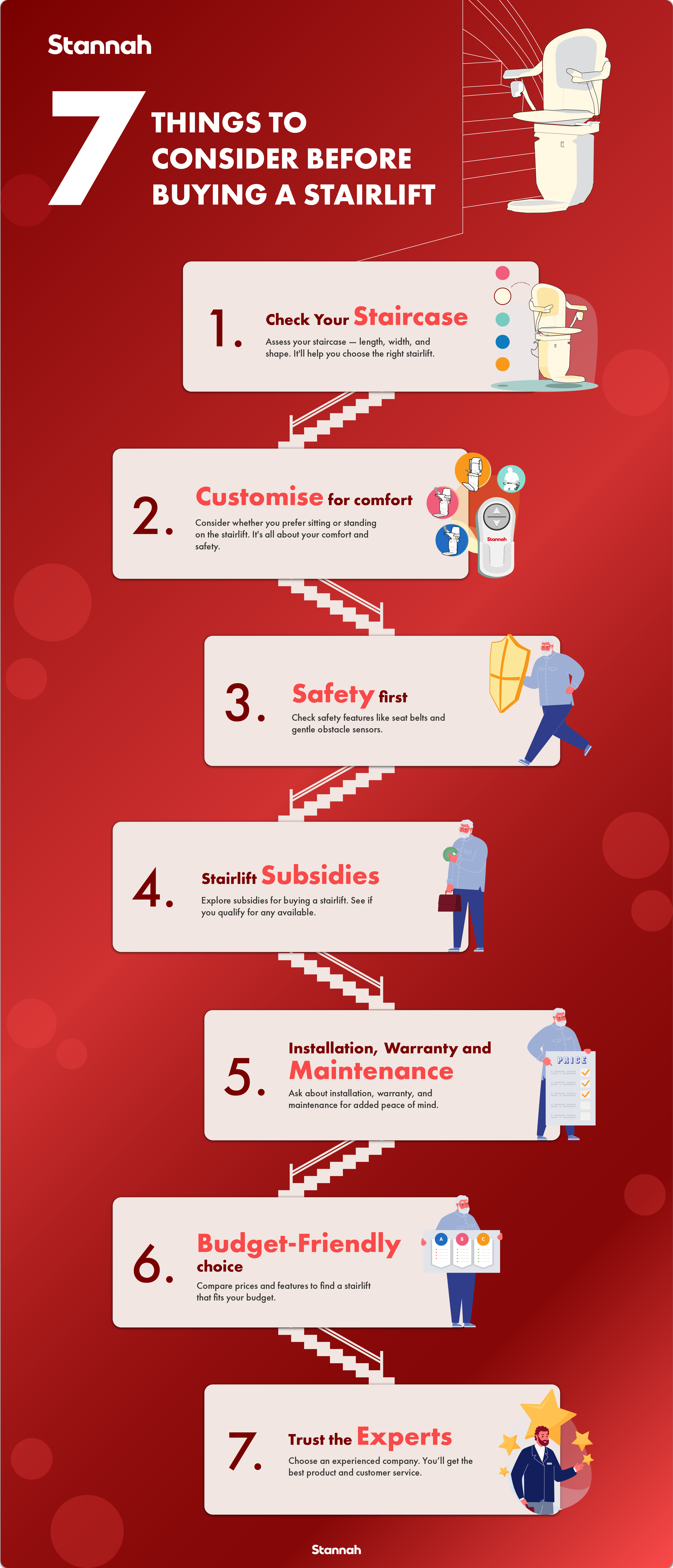
Now that you’ve got the basics covered, let’s dive deeper into our comprehensive stairlift guide and discover the various types of stairlifts available, their unique features and benefits, and much more.
You’ll have all the information you need to make an informed decision and transform your home into a more accessible place for you and your loved ones. Let’s get started!
How a Stairlift Works
Stairlifts employ a battery-powered rack and pinion drive system that is constantly charged by a nearby outlet at the top or bottom of the stairs.
This allows an electric stairlift to carry its rated load up and downstairs, while the overspeed governor and emergency braking system ensure that the stairlift will never travel faster than it is supposed to.
Batteries
The main power supplied by the electrical outlet helps the batteries maintain a full charge, so that your stairlift is ready to go at all times. However, the stairlift won’t overdraw from your electrical supply and the minimal output means there won’t be any significant impact on your electric bill. You can learn more about energy efficient stairlifts from Stannah here.
Power Outage
In the event of a power outage, the batteries will continue to operate your stairlift for approximately 20 roundtrips. In this situation, you can usually save battery power by turning off an isolator switch when you aren’t using the stairlift. However, this is only recommended during an outage and it’s important to leave your stairlift switched on the rest of the time.
Replacing the Batteries
Stairlift batteries last between 1 and 5 years, depending on usage and how often the stairlift is left off charge. When it’s time to get them replaced, a professional technician can service your batteries for you.
Unfortunately, this isn’t something that you can do on your own, as these industrial batteries are stored within the stairlift’s carriage and require technical training to install. However, stairlift batteries are usually covered under an initial warranty or extended service plan.
Weight Capacity
Stairlift weight capacity depends on your staircase type and the model you need for your home.
Straight stairlifts can carry heavier loads than curved stairlifts, which operate on a different track that has to adapt to the bends and turns of your staircase. Typically, stairlifts can support between 135 kg – 160 kg.
Stairlift dimensions
The dimensions of a stairlift are a crucial factor you should consider when choosing the right solution for your home mobility needs. These chairs are designed to fit a variety of staircase types, so dimensions may vary. Two key measurements are the seat width and the overall depth of the chair.
The seat width should be wide enough to provide you with comfort as you move. Additionally, it’s essential to measure the distance from the seat to the top of the stairs once the chair is in its highest position. This ensures that the chair doesn’t interfere with space at the top.
Types of Stairlifts
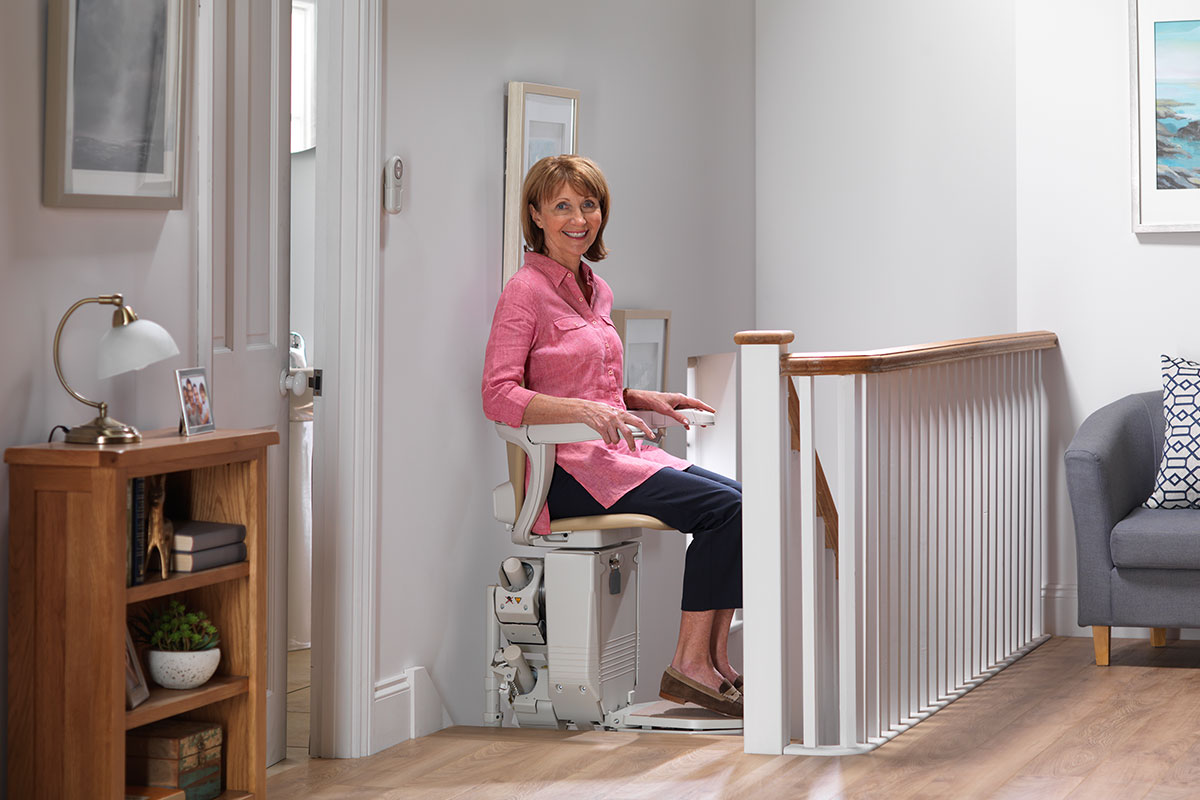
There are three basic stairlift types: straight, curved and outdoor. Each is suited to a different type of staircase and comes with a unique set of attributes and benefits. Let’s take a look at the different stairlift types, so you can figure out which is right for you.
Straight Stairlifts
Straight stairlifts are the most common type of stairlifts, as they’re designed for simple, straight-run staircases. Usually, staircases have between 12 and 16 steps, but every house is different and a straight stairlift can be installed on a staircase that’s up to 12 metres long.
Curved Stairlifts
Stairs that turn require a bit more work than straight-runs. Fortunately, curved stairlifts can handle the bends and turns of almost any staircase. Whether the turns are gentle or sharp, the advanced design of curved stairlifts allows them to adapt and negotiate each curve with precision and stability.
Outdoor Stairlifts
Outdoor Stairlifts are just that: stairlifts designed for outdoor staircases. They provide access to backyards, gardens and even garage entryways. These models are built to withstand harsh weather conditions, including extreme heat and cold.
Who Can Use a Stairlift?
So, now that we’ve covered the basics, the question becomes, “who can use a stairlift?” While most people can operate a stairlift, it’s important to make sure that you have the mobility required to get in and out of the chair safely. Let’s look a t few scenarios and see if a stairlift is right for you.
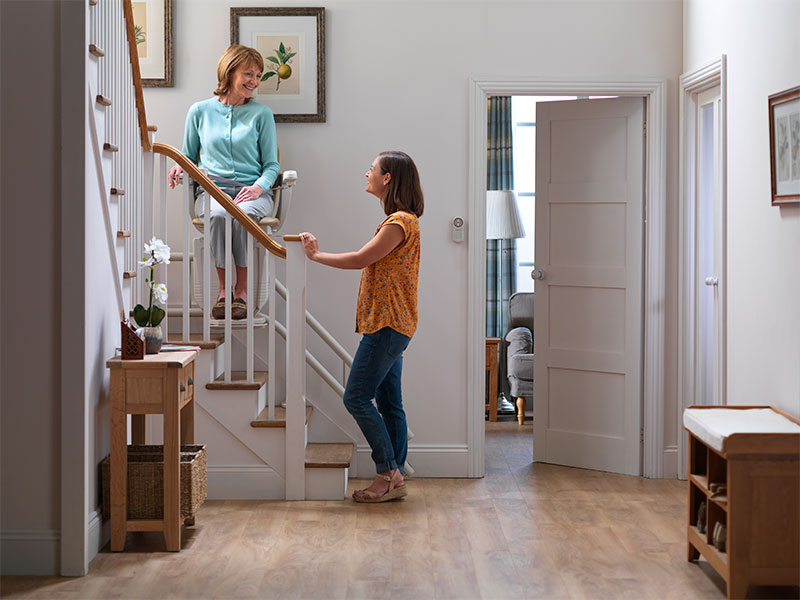
Seniors
Typically, seniors are the group most associated with stairlifts. And, right enough, they are the leading demographic of stairlift users. It’s only natural that our mobility should decline as we get older and with so many seniors focused on aging in place, stairlifts provide an attractive alternative to moving or remodeling.
For many seniors, their home is their castle. Some have even lived in the same house for decades, so, the prospect of picking up and moving can be hard.
Stairlifts make aging in place a real possibility for these seniors, and their easy functionality and ergonomic designs help seniors save their physical energy for the rest of the day.
People with limited mobility
Of course, you don’t have to be a senior to use a stairlift, anyone with limited mobility can benefit. Stairlifts can help those with chronic conditions, degenerative injuries or even provide relief during a temporary recovery from surgery. The most important factor is being able to get in and out of the chair safely.
Even if you struggle to sit down there are standing models or perch stairlifts, like our Sadler stairlift, that can accommodate your needs.
A Person Who Uses a Wheelchair
Those living with permanent disabilities and people who use wheelchairs might have a harder time using a stairlift, but it really depends on the situation. A stairlift is not a platform lift and cannot carry a wheelchair upstairs.
So, for wheelchair users to operate a stairlift, they will need to have wheelchairs stationed near the top and bottom of the stairs.
They’ll also need to be able to transfer from their wheelchair to the stairlift’s seat and back again. This can be done with help, but it’s better if the user can perform this task independently. Everyone’s mobility is different and the best way to find out if a stairlift will work for you is to stop by a local showroom and see for yourself.
Safety Features & Options
In addition to some of the standard features, many stairlifts can be supplied with options to make them even safer and easier to use.
Safety Sensors
Almost every stairlift on the market is equipped with safety sensors beneath the footrest and on the sides of the motorized carriage. This ensures that the stairlift will come to a gentle, but immediate stop if it encounters an obstruction.
Retractable Rail
Retractable rails are an optional feature for staircases with limited space at the bottom landing. The rail raises and lowers automatically as the chair rides up and down the stairs, clearing room for a door or walkway. This prevents the rail from becoming a tripping hazard or blocking an emergency exit.
Folding Footrest
Just about every major stairlift company carries models that fold up to save space on the stairs, when not in use. The seat and armrests usually flip up manually, but the best companies provide powered footrests.
These usually include a button on the armrest that folds the footrest up and down, making it easier to get in and out of the chair and avoiding the need to bend over when folding the footrest (especially important at the top of the stairs).
Seat belt types
Quality seatbelt options can make a big difference for stairlift users. While the industry standard is a simplified “center-clasp” seatbelt (similar to a backpack strap), companies, like Stannah, go above and beyond with their seatbelt options.
Our retractable seatbelt is mounted to the armrest and easy to grasp and fasten, even with arthritic fingers. The ‘Immobilizer’ seat belt prevents the chair from operating l until the seatbelt is engaged. Lap-diagonal and five-point harness seatbelts provide extra restraint over the shoulders and, if needed, between the legs.
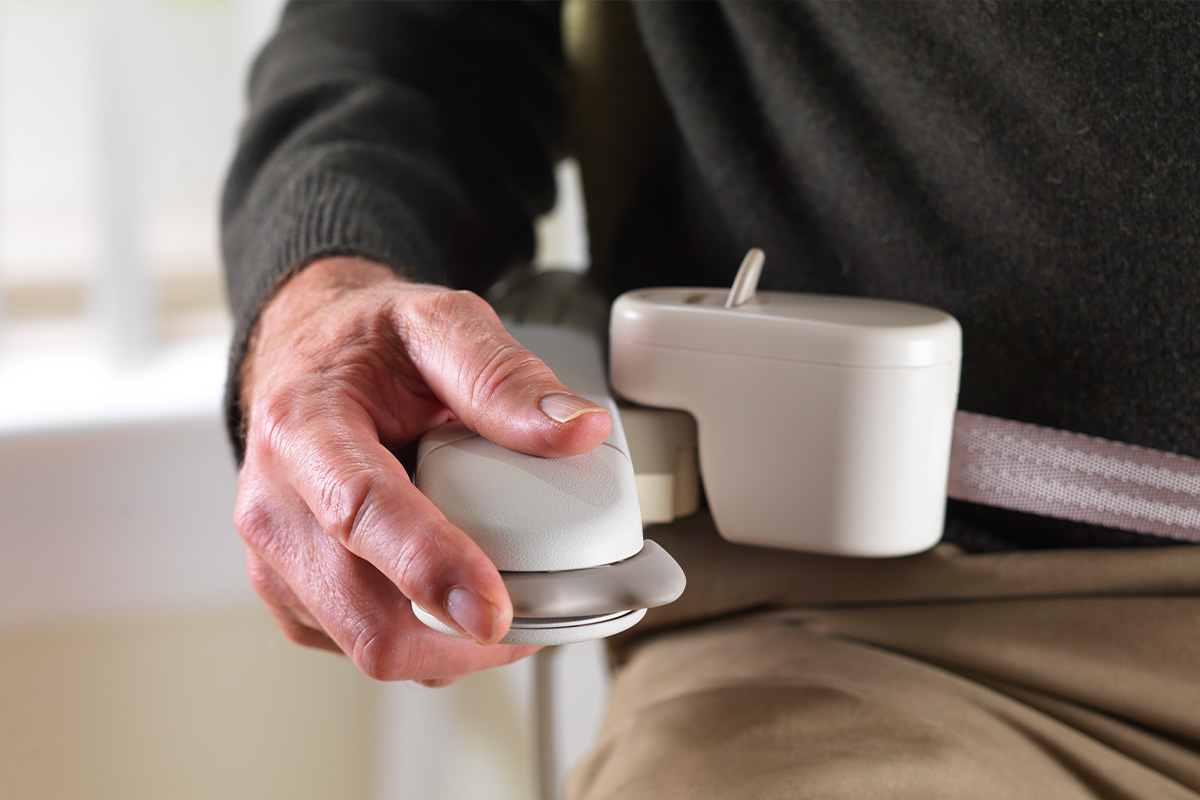
Controls
The slimline hand control is mounted to the armrest and allows you to use any part of your hand to operate the stairlift. Simply push and hold the control in the direction that you want to go to move your stairlift. If you let go, the stairlift will stop. The hand control is soft and ergonomically designed for those with limited dexterity. An alternative “rudder” style is also available.
Key Lock
The key lock feature prevents unauthorized use of your stairlift. Simply remove the key and no one else will be able to use the stairlift. When you’re ready to go, replace the key. If you aren’t concerned about others using the stairlift, you can leave the key in all the time.
Types of Seats
There are several types of stairlift seats to choose from. While it’s important to find something comfortable, you should also make sure that you select a seat with the practical features that will suit your needs.
Wider chair arms provide extra space and have the added benefit of offering more leverage when you’re getting up from the seated position.
Perch/standing models like our Sadler stairlift are a good solution for those who struggle to bend their knees or have back problems. You can ride upstairs in a semi-standing position and the hydraulic seat will make getting out of the chair much easier.
In addition to these practical features, many stairlifts offer intriguing style options. You can get vinyl or woven upholstery and choose from a variety of colors. Some stairlifts even come with light or dark wood trim. Once you’ve found the seat that will suit your needs, choose the style options that will suit your home!
Stairlift Prices
While a stairlift is a much cheaper option than moving, remodelling or entering an assisted living facility, stairlift prices and installation costs are still important factors to consider.

The cost of a stairlift is determined by the shape of your stairs and the unique set of options you need. These options include features like the retractable rail for stairs with a walkway or door at the bottom or the powered swivel seat, which helps the user turn onto the top landing more easily. So, it’s important to speak to a professional to get pricing for your home.
In the meantime, here are some stairlift pricing basics to get you started.
- Straight stairlift prices: The price of your straight stairlift will depend mainly on how long the rail needs to be. Because straight stairlifts are housed locally and cut to length on order, they can usually be installed much quicker than curved models.
- Curved Stairlift prices: It’s difficult to give exact figures, as the specifics of your staircase determine much of the cost. Unlike straight stairlifts, curved pricing is more about the shape of your stairs than the options you select. Rail length and the number of turns make the biggest difference, but add-ons, like the powered swivel and custom upholstery, are still available.
- Outdoor stairlift prices: Outdoor stairlifts cost may vary in your local area. Outdoor stairlifts are built to withstand harsh weather and are usually backed by a strong warranty. Though outdoor stairlifts rarely have additional options, many come with protective covers that prolong the life of the stairlift through inclement weather.
Cost-efficiency
Ultimately, the decision to purchase a stairlift is about value. While in some cases, the initial investment can be reasonably high, they’re actually quite low when compared to the prices commonly quoted for a major home remodeling or a month in an assisted living facility.
While moving a bedroom down to the ground floor is the cheapest option, is single-story living in a multi-story home really the ideal scenario? A stairlift allows you to enjoy the full use of your home without being impeded by the stairs.
When you factor in that quality stairlifts have been known to last upwards of twenty years, there’s really no better value to be had.
Tips for Choosing the Right Stairlift
Choosing the right stairlift is all about finding the best value for your situation. Often, the cheapest option isn’t the best solution; neither is the most expensive model. Here are few important factors that can help you find the right balance for your needs and for your budget.
- Think about how long you want to live in your home. Renting can be a great temporary solution, especially if your recovery is only temporary. But, if you plan on living in your home for longer than 18 months, you’re usually better off purchasing the stairlift outright.
- Consider how your mobility might change. People often think about the stairlift process in terms of their current mobility level. Unfortunately, that can change over time. Make sure you choose a stairlift that can adapt to your needs as they change over time, because if it’s a struggle to use now, it will only get harder down the road.
- Determine the value of the full package. Many online realtors offer enticing prices, with little follow through on the back end. There’s a big difference between a stairlift in a box delivered to your doorstep and a safe, professional installation backed by a multi-year warranty. When choosing a stairlift (and a stairlift company) it’s important to consider the long-term value. While upfront costs are important, you should always be asking, “What am I getting in the long run?” Whatever factors matter most to you, the answer should include both independence and peace of mind.
Paying for a Stairlift
As we discussed in the stairlift pricing section, cost is a major concern and one of the most important factors in the buying process.
While it’s important to consider the total value of a stairlift purchase, the reality of the upfront cost have to be taken into account as well.
That’s why many stairlift companies offer payment plans and buying options to help spread out the cost. Payment options vary, depending on the company you choose, but you should ask about:
- Payment plans: Sometimes, stairlift companies will allow you to spread out payment for a stairlift, billing you monthly until your purchase has been paid off. While not a common practice, it’s worth asking your stairlift company about this option.
- Rentals: Stairlift rentals offer a way to spread out costs while you make sure that the stairlift is the right decision for you. Temporary rentals cost a fraction of the purchase price and with all service covered during the rental period, you can take your time, before deciding if you want to keep the stairlift for good.
Installation and Maintenance
Once you’ve completed your research, chosen a stairlift company, settled on a set of options and secured funding, it’s time to move forward with your stairlift installation.
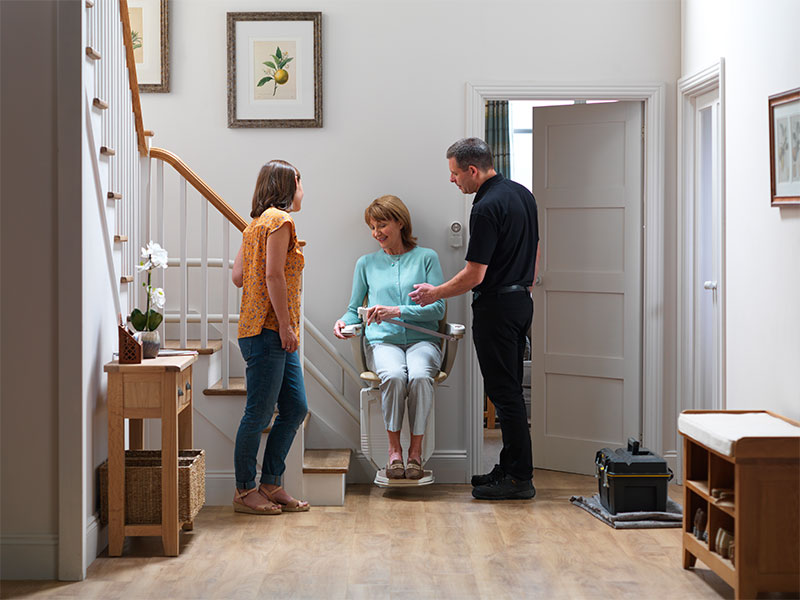
At Stannah, we make this process as easy as possible. We’ll usually schedule a date with you over the phone when you place your order, and you’ll get a confirmation call the day before installation.
Whether you’re working with us directly or having a stairlift installed by one of our trusted dealers, you can be sure that you’re getting the full Stannah experience. That means:
- Skilled technicians, who have been thoroughly trained to install your stairlift safely.
- A quality installation, done in a neat and timely fashion.
- Thorough product training, with helpful demonstrations.
- Product literature and access to aftercare service.
Not only are our dealers trained to maintain Stannah’s installation standards, they’re also tasked with upholding our company values. We only work with reputable professionals who share in our commitment to quality craftsmanship, exceptional service and honest sales practices.
We put our name on our products and our trust in our dealers. So, whether you’re in our backyard or purchasing your Stannah stairlift through a distributor, you can put your mind at ease.
We also recommend an annual service to ensure that your stairlift is operating at peak condition. While repair services are covered in your initial warranty, you can also purchase service plans and extended warranties to maintain this coverage after the initial warranty has run out.
However, even without an extended warranty or service plan, repair services and annual maintenances can be scheduled as needed.
Stairlift Warranty
Stairlift warranties consist of a few different layers of coverage. The principle elements of a stairlift warranty are parts coverage, rail and motor/gearbox coverage.
If you’re working with us directly, you’ll have access to Stannah’s leading stairlift warranty. That means an efficient maintenance and call-out service to make sure we’re there for you whatever happens.
Contact Stannah
Well, that about covers it. Now, it’s up to you! If you’re ready to take the next step, get in touch with us today. We’ll be happy to help you find the right stairlift, one that will help you live independently in the home you love for years to come.
